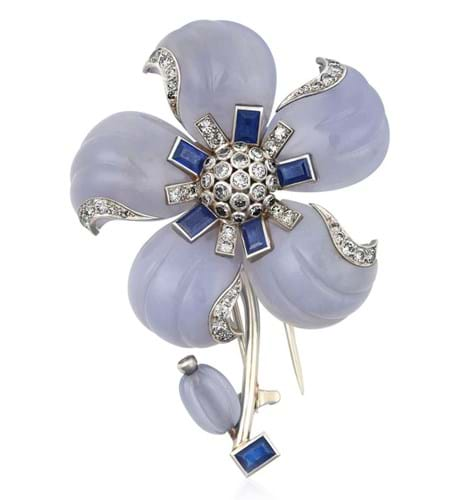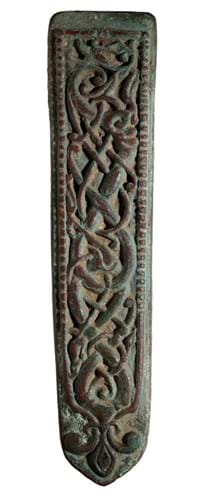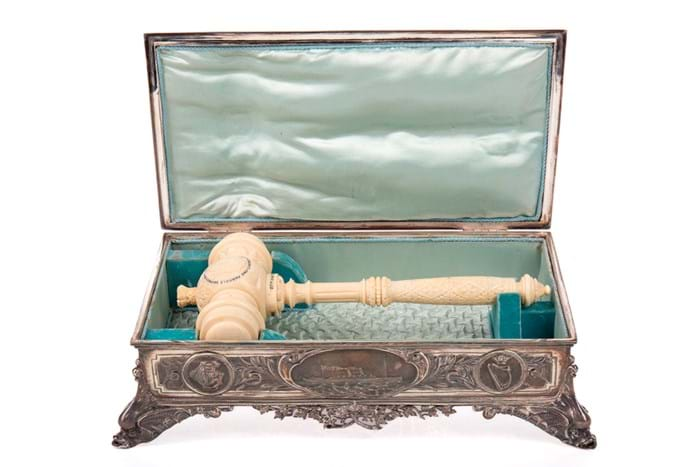1. Suzanne Belperron brooch – £38,000
This chalcedony, sapphire and diamond flower brooch by Suzanne Belperron (1900-83) was included in Tennants’ Fine Jewellery, Watches and Silver sale on July 15 with an estimate of £5000-7000. It made £38,000.
The brooch was the property of a lady who was given it on her wedding day in 1952 by the Italian noblewoman Marchesa Maria Nunziate di Mignano.
Belperron began her career in jewellery design in 1919 at the House of René Boivin, the famed Parisian jewellers, before leaving to become the chief designer at Bernard Herz in 1932. After Herz’s death she took over the company, renaming it Herz-Belperron.
Like others of her generation, she favoured working with ‘semi-precious’ materials such as agate, rock crystal and the chalcedony used here to such great effect. She never signed her pieces, famously quipping ‘my style is my signature’.
2. Crested china collection – £3300

A Goss model of the Massachusetts Hall, Harvard from a collection of crested china sold for £3300 at Leighton Hall Auctions.
Forty years ago, the market for crested china was booming – the subject of specialist sales, annual price guides and an international collecting base. The market today is much smaller with the majority of once carefully assembled collections offered at auction as single group lots.
So, it was when a large collection of crested wares appeared for sale at Leighton Hall Auctions in Alton, Staffordshire on July 15. However, those who viewed the online pictures of this box lot will have quickly homed in on one of the rarest of all the 40 Goss ‘cottage’ models – the Massachusetts Hall, Harvard nightlight.
This 7in (17cm) unglazed model with polychrome enamel decoration was first registered in 1914 and listed as a new model in the 8th edition of The Goss Record alongside models of Wordsworth’s Birthplace, Cockermouth and Southampton Tudor House.
Other good pieces in the lot included a Goss model of Huer's House Cornwall and one of the earliest of the Goss cottages, Manx Cottage registered in 1896 offered here in the large-scale ‘night light’ size.
Estimated at just £10-20, the lot sold at £3300.
3. Silver plaquette Commons Speaker Lenthall – £7500

Silver portrait plaquette of William Lenthall, the Speaker of the Houses of Commons from 1640-60, £7500 at Bonhams.
William Lenthall (1591-1662) was chosen as Speaker of the Houses of Commons at the beginning of the Long Parliament in 1640. He continued in the role under Cromwell’s Protectorate and remained in the role when the Long Parliament was restored in 1659.
On January 4, 1642, when Charles I entered the House of Commons to arrest five MPs for treason, he famously refused to reveal their whereabouts saying: “May it please your Majesty, I have neither eyes to see nor tongue to speak in this place but as the House is pleased to direct me, whose servant I am here.”
This 9cm silver plaquette, marked CF and made around 1653 (probably in the Low Countries), has an extensive provenance that includes several famous Victorian numismatic collections. Last sold by Spink & Son in 1910, it was purchased by Vernon James Watney (1860-1928) of Watney Brewery fame and came by descent to Bonhams’ Fine Decorative Arts auction in New Bond Street on July 12. The estimate was £3000-5000 and it brought £7500.
Bonhams’ cataloguer Cecile Shannon said the plaque can be read in two different ways. It is either simply a celebration of Lenthall’s achievements or, alternatively, an overt criticism of his character. On close examination the lion’s mask on his arm resembles the face of the devil – a reference perhaps to Lenthall’s tendency to switch political allegiance depending on who was in power.
4. 11th century bronze die – £15,000
This 11th century bronze die worked with interlace would have been used to make the cheek guards of Viking helmets. The design is known as Urnes style ornamentation and probably represents the world tree Yggdrasil with the monstrous serpent Nidhogg intertwining within its roots.
It was discovered in a field in Norfolk by a metal detectorist in January this year. After posting an image on Facebook, it was identified as Viking in date and the recorded via the Portable Antiquities Scheme.
It had expectations of £16,000-24,000 when it came for sale at Noonans’s on July 18. It fell a little short of its estimate but sold nonetheless at £15,000. The money will be shared between the finder and the landowner.
5. Launching mallet from sunken steamship – £10,000
The ivory launching mallet and silver casket from the ill-fated RMS Empress of Ireland came for sale at McTear’s Fine Furniture & Works of Art auction in Glasgow on July 20.
Commissioned by Canadian Pacific Steamships for transatlantic crossings, the Empress of Ireland was built at Govan Shipyards by the Fairfield Shipbuilding and Engineering Company. She was launched in 1906.
Tragically, on May 29, 1914 – only two years after the sinking of the Titanic – the Empress went down in the Saint Lawrence River following a collision with the Norwegian collier S.S. Storstad. The disaster claimed the lives of 1012 passengers and crew members, making it the worst peacetime marine disaster in Canadian history.
The carved, turned and inscribed ivory launching mallet and Edwardian silver casket was gifted at the time to the wife of Sir Alexander Gracie, a member of the Fairfield board of directors. They came to auction by family descent.
The historic maritime lot was expected to bring £10,000-15,000 and took its low estimate.
The mallet is one of a relatively small number of solid ivory items that have come to auction in the UK since the Ivory Act was implemented in 2022. It had been granted an exemption on the grounds of its ‘outstanding artistic, historical or cultural value’.








